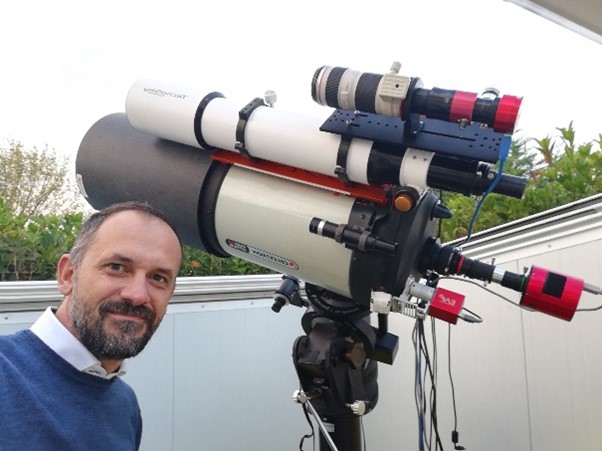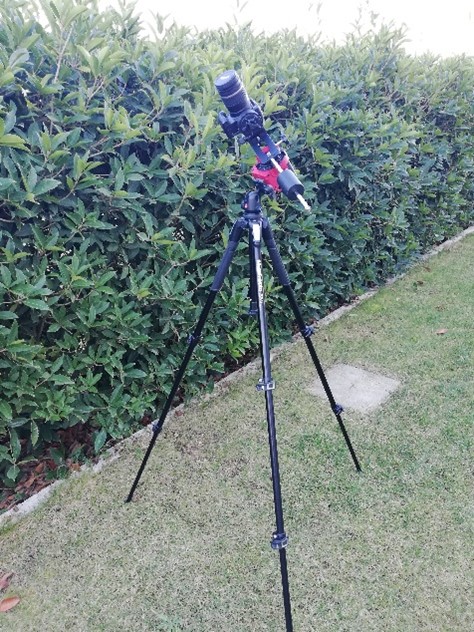Hello Alessandro, thanks for accepting our interview invitation. Congratulations for winning ASIWEEK competition in week #52 2022!
Q1: Could you please make a self-introduction first?
Hello everybody, my name is Alessandro Ravagnin and I was born 45 years ago in Venice, one of the most famous and ancient cities of Italy. I’m a telecommunications engineer with an ancestral passion for astronomy, astrophysics and volleyball! Nowadays I live in Romano d’Ezzelino, 50 km far from Venice in the north-east of Italy, with my wife Elisa and my young children Andrea e Davide. I work as a Marketing Manager in an important Italian company located in Marostica.
 Me and my family at the astrophysical observatory of Asiago
Me and my family at the astrophysical observatory of Asiago
 Me at the Astronomical observatory of Col Drusciè (Cortina)
Me at the Astronomical observatory of Col Drusciè (Cortina)
Q2: What makes you become an astrophotographer and how long have you been?
My passion for astronomy started 31 years ago. I remember that day very well: my parents gave me my first telescope (yellow Konus refractor with 60mm of diameter) for my 14th birthday. I randomly pointed the telescope to a small bright dot above the lights of Marghera (industrial town closed to my home). In that moment my journey through the Universe began: Saturn and its rings ignited the flame of my passion for the sky.
 Target: Saturn. Equipment: Celestron 11” HD Edge + ZWO ASI290MC + Barlow Televue 2x + IR Cut Optplong
Target: Saturn. Equipment: Celestron 11” HD Edge + ZWO ASI290MC + Barlow Televue 2x + IR Cut Optplong
Q3: Do you have any other hobbies besides astrophotography? Do you think is there any connection between them?
I’ve been playing Volleyball for 33 years! I don’t know if we can consider this passion as a “hobby”, but Volleyball is the way I love spending my free time.
I love hiking and skiing (our Dolomites are fantastic!!!), collecting F1 Ferrari die-cast models, amazing action figures of past Japanese Robots, mounting LEGO spaceships and assembling plastic models of Spacecrafts.
And of course, there is no connection between all these hobbies…only me!
Q4: We all know that astrophotography is a very difficult hobby with a very high threshold, so how did you overcome the steep learning curve?
I’ve never had any difficulty, maybe because of my engineering skills and also because I started photographing the sky with analogic reflex cameras when I was 18 years old. I remember I’ve been one of the first early adopters in digital acquisitions of planetary images with the old Philips TouCam and Philips Vesta cameras.
Q5: Do you still remember your first astrophotography experience? What feelings did you have when you saw your first astrophoto?
Oh yes! This is my first image of the sky ever taken. An incredible mix of emotions!!!
 My first photograph ever taken: M42
My first photograph ever taken: M42
 My first photoalbum
My first photoalbum
Q6: What gear do you use, any photos of them?
Due to (thanks to!) COVID19, I completely renewed my gear. I built an observatory in my garden, named ADAM (the first letters of my children, my parents and the parents of my wife), buying the following telescopes and accessories in more or less two years:
Celestron 11” HD Edge
Tecnosky 115/800mm refractor
Canon 200mm f/4
EQ8 Sky-watcher mount
Star Adventure Sky-watcher mount
ZWO ASI cameras and accessories: ASI2600MC Pro, ASI183MM, ASI290MC, 2 ZWO EAF Focuser
Filters: Optolong L-Extreme, UHC, UV/IR Cut; Daystar Quark Prominence and Baader Astrosolar 28cm
Tecnoshelter 2×2: automatic dome with electric roof and integrated with my Home Automation System (by Vimar, the company I work for)
 My observatory in the north east of Italy: ADAM (Andrea, Davide, Alberto-Alfio-AnnaRosa and Maria)
My observatory in the north east of Italy: ADAM (Andrea, Davide, Alberto-Alfio-AnnaRosa and Maria)
 Me with my equipment
Me with my equipment
And my old friend, that is still here with me!!! I will never sell it: one Classic Orange C8, built in the USA last 1984, owned with great care starting from my 18th birthday (it succeeded the Konus refractor, I used it till the arrival of its big brother, the C11HD)!
 Classic Orange C8 + 115/800mm refractor
Classic Orange C8 + 115/800mm refractor
Q7: Where do you usually take astrophotos, somewhere remote from home or just in your backyard?
I love taking pictures from my backyard, I’ve built ADAM for this purpose mainly. Sometimes, when I go on vacation to the Dolomites, I like to bring with me the “lightweight setup” (Star Adventurer + Canon EOS with 70-200mm f/4 lens + ASI2600MC Pro).
 Lightweight Setup
Lightweight Setup
Q8: What do you think astrophotography has brought to your life? Does it change you in any sort?
For sure, astrophotography changed my bank account! This hobby is very expensive, but it allows us to better see the beauties of our universe, to be aware of and discover its mysteries. In the last 2 years, thanks to my results, I had the chance to get in touch with many different professional astronomers: I’ve read their professional research and this helped me to complete my projects with some scientific deep views of the targets. This has been very amazing! I elevated my “amateur passion” to something more interesting and scientific than the simplest “astrophotography”.
Q9: As to your winning image, Solar Eclipse, would you please tell us how did you capture it? Would you like to share with us some detailed camera settings?
I applied the same technique I used to photograph and process the previous partial eclipse of the sun on the 10th of June 2021. That picture was shortlisted at the 14th annual Astronomy Photographer of the Year contest (Royal Greenwich Museum). I found the way to connect my Daystar Quark Prominence filter with my standard Canon 200mm f/4 lens. Thanks to the tiny and sensitive pixels of ASI183MM camera, I’ve been able to reach a good resolution. I took 2000 frames in a unique movie and I stacked the best 300 frames with ROI 3500×3500 pixels, bin1, gain 50 and exposition time 6ms. The post processing was done with Gimp only, with an inverted technique to enhance the prominences on the limb.
 Target: Solar Eclipse. Equipment: Canon 200mm f/4 + ZWO ASI183MM + Sky-Watcher EQ8 mount
Target: Solar Eclipse. Equipment: Canon 200mm f/4 + ZWO ASI183MM + Sky-Watcher EQ8 mount
Q10: Astrophotography has been through a deep revolution in the last decades. Do you have any thoughts about this to share with us?
I don’t have enough words to comment on this fact. A few years ago, I never thought that nowadays I would be able to do what I am able to do. Incredible.
Q11: What are the most important keys for you to choose an astronomical dedicated camera?
I chose ZWO’s products because of its ecosystem! Huge range of cameras and accessories with unique and practical software, a good quality, and price ratio.
Q12: Planetary imaging and DSO imaging, which one do you prefer and think it is more challenging?
I spent the first part of my “astronomic life” shooting the Moon and the Planets cause I could take pictures of bright targets only where I was in Venice. But now I live in a house located in a suburban location and I can focus my efforts and time on Deep Sky Objects. Unfortunately, I have to fight the light pollution and my terrible Bortle 7/8 sky…(sometimes, after the storms, I can reach 6/7, but twice per year!)
That’s why, sometimes, I try to do both (Planetary & DSO Imaging) at the same time: High resolution on Deep Sky Objects.
It is interesting to shoot small bright nebulae (like the planetary ones) trying to reach the maximum achievable resolution from my setup.
Maybe this is the reason why I’ve been able to win, 6 months ago, the ASIWEEK #33/2022 with the image of the core of the Cat’s eye Nebula.
 Target: Cat’s Eye Nebula. Equipment: Celestron C11 Edge HD f/10 + ZWO ASI2600MC Pro + UHC and L-extreme filters
Target: Cat’s Eye Nebula. Equipment: Celestron C11 Edge HD f/10 + ZWO ASI2600MC Pro + UHC and L-extreme filters
Q13: Do you have any unfulfilled wishes in astrophotography? How are you going to fulfill them?
In my life, I’ve seen the most beautiful objects and events of our universe:
Sun and moon becoming dark due to the mutual eclipses, the planets of our solar system dancing around our sun, sand storms covering the red disk of Mars, comet crashing Jupiter, Venus and Mercury transiting above the Sun, the Space Shuttle docking the ISS, our Milky Way with its pulsars pulsating, Wolf-rayet and symbiotic binary stars creating fascinating nebulae, synchrotron emissions coming from the black holes, expansions of the bipolar nebular emission originating from nova events, all kind of nebulae and galaxies, galaxies clusters and superclusters, distant quasars and supernovae.
 Some beautiful targets end events: WR134, Venus transiting above the Sun,the Andromeda galaxy, the outer solar system.
Some beautiful targets end events: WR134, Venus transiting above the Sun,the Andromeda galaxy, the outer solar system.
What is missing? Gravitational lenses and Auroras. I have to schedule a trip to the northern European cold countries…maybe it would be easier to take a picture from my backyard of a faint light coming from a very far away galaxy, distorted by a closer one, but I’ll try to schedule this trip!
Q14: What new ASI products do you expect?
I suppose you will continue improving your catalogue related to your main business by designing more robust/affordable/functional cameras and by implementing new software functionalities for ASIStudio (that I like very much, maybe one of the main reasons why I have only red products in my setup). If your business of AM5 Mount starts well, maybe you will add more products into this line of business.
With reference to ASIStudio, which I really like, I hope you will develop a tool to better automate the acquisition session (focus adjustment routine and filter wheel control every tot subs).
Q15: Would you like to share with us your project plans in the future?
I will continue with my two main open projects: “FOTONIContest” and “ShaRA”.
The first one was born during the Italian COVID19 lockdown: it’s a new way to share the passion for astrophotography with friends, shooting the same target in the same period of the year and mixing the results in a unique picture.
The second one was born after the last edition of FOTONIContest and it is based on crowdfunding for buying observing time with big remote telescopes located in Chile.
 My new project
My new project
After these, for sure, a trip to the north…to see one amazing Auror!

what a great website!!! this help me so much!!! thank u so much!
1
0
what a great website!!! this help me so much!!! thank u so much!
1
0